Unlocking 25 MPa Bond Strength in Aluminium-Steel Hybrid Castings: A Deep Dive into HPDC Process Optimization
This technical summary is based on the academic paper "Influence of high-pressure die casting parameters on bonding characteristics of aluminium-steel hybrid-castings for automotive lightweight structures" by Florian Mielke, Damian Sulik, and Xiangfan Fang, published in the Journal of Manufacturing Processes (2025).
![Fig. 1. a) Cross-section scheme of the PVD AlSi columnar grain structure [29] and b) SEM image of the coating surface](https://castman.co.kr/wp-content/uploads/image-3677.webp)
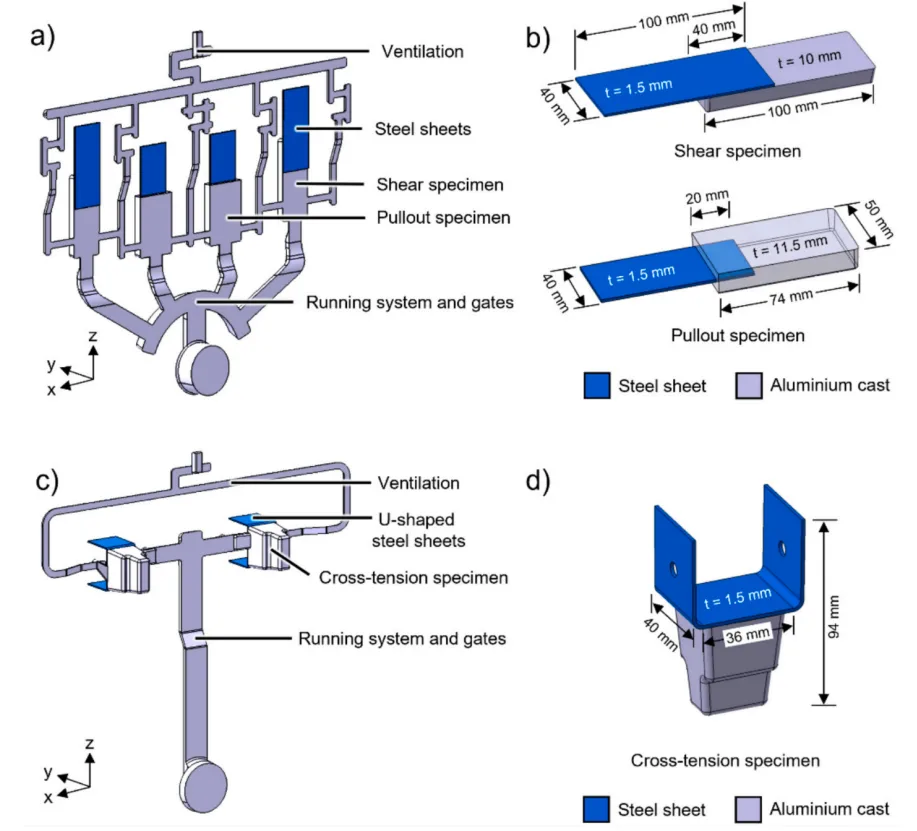
Keywords
- Primary Keyword: Aluminium-Steel Hybrid Casting
- Secondary Keywords: High-pressure die casting (HPDC), bonding strength, process parameters, automotive lightweighting, multi-material design, AlSi(Fe) coating
Executive Summary
- The Challenge: Achieving a consistently strong and ductile bond between steel and aluminium in high-pressure die casting (HPDC) is a major hurdle for producing reliable, lightweight automotive components.
- The Method: Researchers systematically varied key HPDC parameters—mould temperature, steel insert preheating, and gate velocity—to cast an AlSi10MnMg alloy onto DP800 steel inserts featuring a novel AlSi(Fe) coating.
- The Key Breakthrough: A specific combination of high mould temperature (280 °C), high insert preheating (500 °C), and an optimized gate velocity (40 m/s) increased the material bond shear strength to 15 MPa and the total bonding strength (including force-fit) to an impressive 25 MPa, all while maintaining excellent ductility.
- The Bottom Line: Mould temperature is the single most critical parameter for maximizing the bond strength and quality in aluminium-steel hybrid castings, closely followed by the preheating temperature of the steel insert.
The Challenge: Why This Research Matters for HPDC Professionals
In the relentless pursuit of vehicle efficiency and performance, automotive engineers are increasingly turning to multi-material designs. Combining the strength of steel with the low weight of aluminium is a proven strategy for lightweighting. However, joining these two dissimilar metals is notoriously difficult. While technologies like Gigacasting are gaining traction, they often lead to over-dimensioned parts and high tooling stress.
Aluminium-steel hybrid casting, which integrates the joining process directly into the primary moulding step, offers a streamlined and cost-effective alternative. The challenge has always been the bond itself. Previous attempts often resulted in brittle connections or inconsistent strength, limiting their use in critical structural applications. This research was initiated to overcome these limitations by pinpointing the exact process parameters that create a robust, ductile, and repeatable metallurgical bond.
The Approach: Unpacking the Methodology
To understand the complex interplay of forces during casting, the researchers conducted a systematic study using a state-of-the-art HPDC setup.
Method 1: Advanced Materials and Coating
The study used a primary AlSi10MnMg (EN-AC 43500) aluminium alloy, common in automotive structures, cast onto a 1.5 mm thick cold-rolled DP800 dual-phase steel sheet. The key innovation was the use of a novel PVD-applied AlSi(Fe) coating on the steel insert. This coating, consisting of a thin intermetallic sublayer and a thicker AlSi top layer, was specifically designed to promote a ductile bond, unlike the brittle failures often seen with conventional zinc coatings.
Method 2: Rigorous Parametric Testing
Three key HPDC process parameters were systematically varied to determine their influence on bond quality:
- Mould Temperature (TM): Tested at 180 °C and 280 °C.
- Steel Insert Preheating Temperature (Tp): Tested at 250 °C and 500 °C.
- Injection Gate Velocity (VG): Tested at 20 m/s, 40 m/s, and 60 m/s.
Method 3: Comprehensive Analysis
The resulting hybrid components were subjected to a battery of tests to evaluate the bond. This included mechanical tests on tensile shear, pullout, and cross-tension specimens to measure strength and ductility. These physical tests were complemented by Finite Element (FE) casting simulations to visualize temperature profiles and melt flow, and Scanning Electron Microscopy (SEM) to analyze the fracture surfaces at a microstructural level.
The Breakthrough: Key Findings & Data
The study yielded clear, actionable data that directly links process parameters to bond performance.
Finding 1: Temperature is the Dominant Factor for Bond Strength
The most significant finding is the overwhelming impact of temperature. As shown in the bar chart from Figure 9a, increasing the mould temperature from 180 °C to 280 °C dramatically improved bond strength.
- At a low mould temperature (180 °C), shear strength hovered around 8.1-8.5 MPa, regardless of the insert's preheating temperature.
- At a high mould temperature (280 °C) combined with high insert preheating (500 °C), the mean shear strength jumped by 60% to 15.0 MPa, with significantly less scatter between samples. This combination reduces thermal shock on the insert and allows for the formation of a superior metallurgical bond.
Finding 2: Combining Material Bond and Force-Fit Achieves 25 MPa Strength
The pullout tests revealed the powerful synergy between the metallurgical bond and mechanical force-locking (force-fit). As illustrated in Figure 21, the total bonding strength is a sum of these two components.
- Force-Fit Component: Uncoated samples, which rely only on the shrinkage of the aluminium around the steel, showed a pullout strength of 8.1 MPa.
- Total Bonding Strength: Coated samples produced under optimal conditions reached a mean total pullout strength of 24.2 MPa.
By subtracting the force-fit component, the pure material bond strength was calculated to be 16.1 MPa, which aligns perfectly with the tensile shear test results. This demonstrates that a well-designed hybrid component can achieve exceptionally high strength levels.
Practical Implications for R&D and Operations
- For Process Engineers: This study suggests that for this coating system, maximizing mould temperature (to 280 °C) and insert preheating temperature (to 500 °C) is the most effective strategy for improving bond strength and consistency. An injection gate velocity of 40 m/s appears to be the optimal balance, as lower speeds risk porosity and higher speeds offer no additional benefit.
- For Quality Control Teams: The data in Figure 11 of the paper illustrates that an elliptical marking on the fracture surface is a visual indicator of a high-strength bond. The detailed SEM analyses of fracture types (Figure 16) provide a powerful diagnostic tool for understanding failure modes and refining process control.
- For Design Engineers: The findings indicate that component designs that leverage both metallurgical bonding and mechanical force-fit (like cast-in inserts) can achieve total bond strengths of up to 25 MPa. This opens new possibilities for creating highly integrated and load-optimized lightweight structures.
Paper Details
Influence of high-pressure die casting parameters on bonding characteristics of aluminium-steel hybrid-castings for automotive lightweight structures
1. Overview:
- Title: Influence of high-pressure die casting parameters on bonding characteristics of aluminium-steel hybrid-castings for automotive lightweight structures
- Author: Florian Mielke, Damian Sulik, Xiangfan Fang
- Year of publication: 2025
- Journal/academic society of publication: Journal of Manufacturing Processes
- Keywords: Steel-aluminium hybrid-casting, High-pressure die casting, Process parameters, Casting simulation, Material bond, Multi-material design
2. Abstract:
For automotive lightweight design, aluminium and steel bi-metallic structures are being increasingly applied. Aluminium-steel hybrid-casting is one of the coming technologies. To achieve a firm bonding between both materials, a new AlSi(Fe) coating was developed and analysed in previous works showing approximately 10 MPa shear strength and high ductility. In this work, a systematic study has been conducted on hybrid-casting of DP800 steel in an AlSi10MnMg alloy using high-pressure die casting (HPDC) trials, its thermal analysis, and mechanical tests on different types of hybrid-cast specimens along with finite element (FE) casting simulation and scanning electron microscopy (SEM) analysis on tested specimens to understand the entire process chain. It was found that the mould temperature is the most important parameter, and the second one is the preheating temperature for the steel insert. With 280 °C mould and 500 °C preheating temperature, and >40 m/s injection gate velocity, the shear strength can be increased to 15 MPa with considerable plastic deformation of the bonding layer and small scatters. Three fracture surface types can be observed by SEM, and clearly understood by considering the temperature profile of the steel inserts during the casting process that can be determined using FE casting simulation calibrated by the casting tests. These findings on shear specimens were further validated by pullout tests with overlapped metallurgical and force-fit bonding, as well as cross-tension tests. Together with force-locking the total bonding strength achieves 25 MPa.
3. Introduction:
The selection of materials is critical for engineering applications, influencing functionality, cost, and performance. In the automotive industry, multi-material designs are imperative for lightweighting and sustainability. While steel and aluminium are classic choices, joining them is difficult due to their different chemical and physical properties. Hybrid casting, which integrates the joining step into the primary moulding process, is a promising method to combine steel inserts with cast aluminium, streamlining production and reducing costs. This approach offers advantages over "Gigacasting," such as better lightweight potential, smaller machine sizes, and longer tool life. A key challenge in HPDC hybrid casting is forming a sound material bond. This study builds upon previous work on a novel, ductile AlSi(Fe) coating, which showed promising but moderate bond strength, suggesting that process parameters could be optimized for further improvement.
4. Summary of the study:
Background of the research topic:
The automotive industry's drive towards lightweight design necessitates the use of multi-material structures, particularly combinations of aluminium and steel. Hybrid casting is an emerging technology to create these structures efficiently.
Status of previous research:
Previous research has explored various surface treatments and coatings (e.g., zinc) to facilitate bonding, but these often result in brittle fracture behavior. A recently developed PVD AlSi(Fe) coating demonstrated a ductile bond with a shear strength of approximately 11 MPa, but it was assumed that optimizing the HPDC process parameters could significantly enhance this performance.
Purpose of the study:
The study aims to systematically evaluate how HPDC process parameters—specifically mould temperature, steel sheet preheating temperature, and gate velocity—affect the mechanical bonding properties of Al-steel hybrid castings that utilize the novel AlSi(Fe) coating. The goal is to identify optimal settings and understand the underlying mechanisms of bond formation.
Core study:
The core of the study involved conducting HPDC trials on DP800 steel inserts coated with AlSi(Fe) and cast with an AlSi10MnMg alloy. The process parameters were varied systematically. The resulting specimens (tensile shear, pullout, and cross-tension) underwent mechanical testing, thermal analysis during the casting cycle, FE casting simulation, and detailed microstructural analysis (SEM/EDX) of the fracture surfaces to correlate process conditions with bonding characteristics.
5. Research Methodology
Research Design:
The study employed a systematic experimental design, varying three key process parameters (mould temperature, preheating temperature, gate velocity) to investigate their influence on the bonding characteristics of hybrid-cast specimens. The findings from tensile shear specimens were then validated using pullout and cross-tension specimen geometries.
Data Collection and Analysis Methods:
- Mechanical Testing: Tensile shear, pullout, and cross-tension tests were performed on a Zwick Roell Z100 universal testing machine. Digital Image Correlation (DIC) was used to measure local strains.
- Thermal Measurement: Type K thermocouples were welded onto steel inserts to record temperature profiles during the pre-casting handling and mould-closing stages.
- Microstructural Analysis: A field-emission scanning electron microscope (FESEM) with energy-dispersive X-ray spectroscopy (EDX) was used to examine fracture surfaces and cross-sections.
- Numerical Simulation: The software WinCast expert was used to conduct 3D FE simulations of the mould filling and solidification process to analyze thermal interactions and melt flow dynamics.
Research Topics and Scope:
The research focused on the bonding of PVD AlSi(Fe) coated DP800 steel with AlSi10MnMg alloy in an HPDC process. The scope included:
- Parameter Variation: Mould temperature (180 °C, 280 °C), steel preheating (250 °C, 500 °C), and gate velocity (20, 40, 60 m/s).
- Specimen Types: Tensile shear, pullout, and cross-tension specimens.
- Analysis: Correlation of process parameters with mechanical strength, ductility, fracture surface morphology, and thermal profiles.
6. Key Results:
Key Results:
- Mould temperature was identified as the most dominant process parameter, with an increase from 180 °C to 280 °C leading to significant improvements in bonding strength.
- Preheating the steel inserts to 500 °C was the second most important factor, effectively enhancing the bond, particularly in combination with the high mould temperature.
- The optimal parameter set (280 °C mould temp., 500 °C preheating temp., and 40 m/s gate velocity) resulted in a shear strength of 15 MPa with considerable ductility and low scatter.
- SEM analysis identified three distinct types of fracture surfaces, whose formation could be explained by the temperature profiles of the steel inserts as determined by FE simulation.
- Pullout tests demonstrated a total bonding strength of 25 MPa, which is a combination of a ~16 MPa material bond and an ~8 MPa force-fit from aluminium shrinkage.
- Cross-tension tests validated the findings from the shear tests, confirming the transferability of the observed process parameter influences to different load cases and geometries.
- The thickness of the intermetallic (IMP) sublayer of the coating (2-3 µm) was found to be unchanged by the hybrid-casting process under all tested conditions.
Figure Name List:
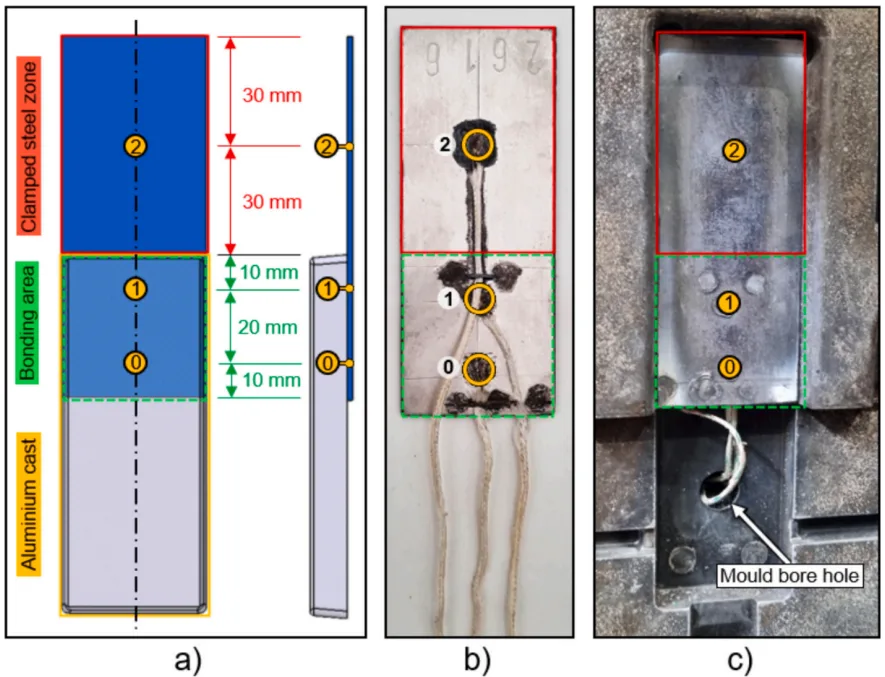
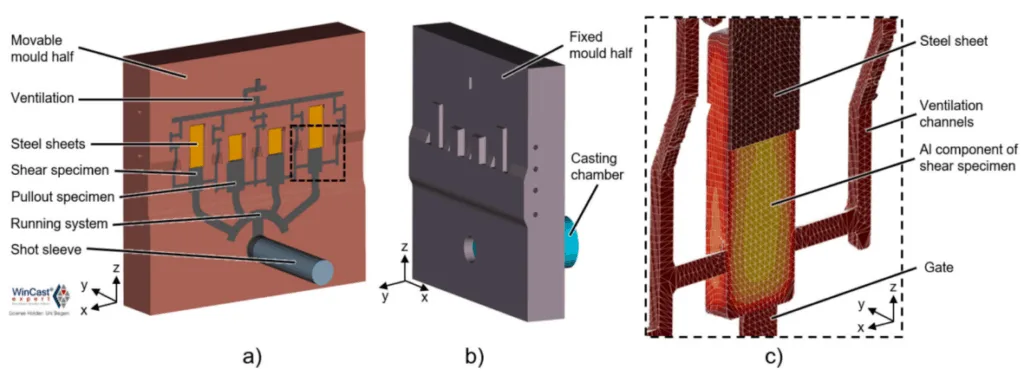
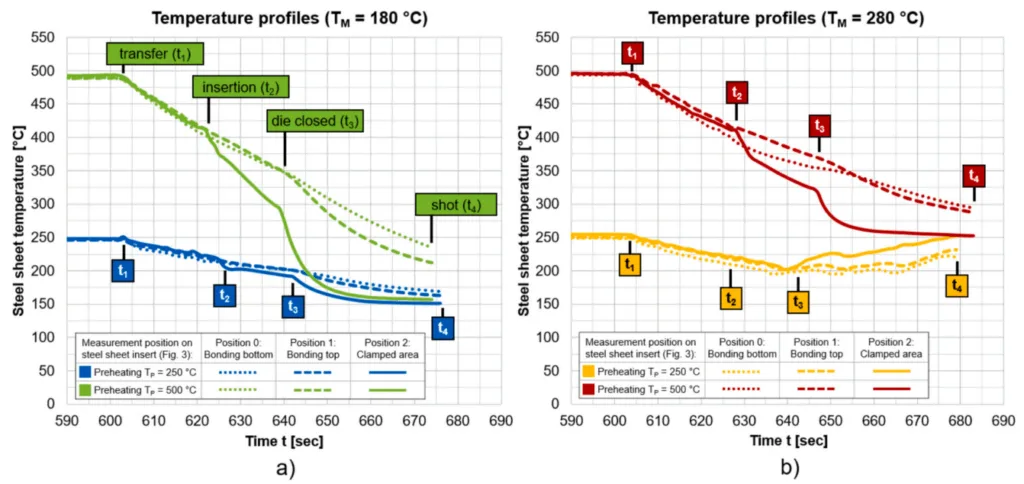
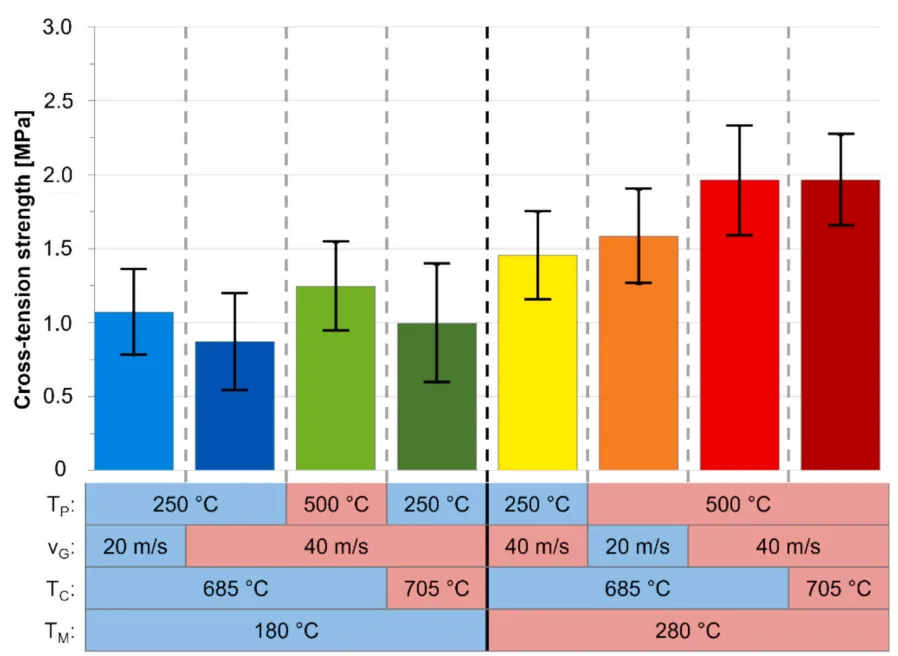

- Fig. 1. a) Cross-section scheme of the PVD AlSi columnar grain structure [29] and b) SEM image of the coating surface.
- Fig. 2. a) First casting die for creating shear and pullout specimen (b) from flat steel sheets and c) second casting die for creating cross-tension specimen (d) from Ushaped steel sheets.
- Fig. 3. a) Schematic illustration of the steel sheet with temperature measurement positions on bottom and top of the bonding area and in the clamped steel zone (positions 0, 1, 2), b) bonding side of the steel sheet with welded thermocouples, c) backside of the sheet positioned in the movable mould half.
- Fig. 4. Components of the numerical casting model: a) aluminium cast components and steel sheet inserts in the movable mould half, b) fixed mould half with casting chamber, c) detailed image of the FE-mesh.
- Fig. 5. a) Thermophysical properties and b) heat transfer coefficients (HTCs) used in the casting simulation.
- Fig. 6. Temperature profiles of steel sheets from furnace transfer to HPDC shot at different mould temperatures: a) 180 °C, b) 280 °C. The locations of temperature measurements (points 0, 1, 2) are indicated in Fig. 3.
- Fig. 7. a) Steel sheet and Al-cast temperature profiles during form-filling and solidification for different mould and preheating temperature settings, b) temperature affected zones of the steel sheets at the points of maximum temperature.
- Fig. 8. Temperature affected zones of the steel sheets during solidification and cooling, shown here for temperature settings TM = 280 °C and Tp = 500 °C.
- Fig. 9. a) Bar chart of the tensile shear strength for different mould and preheating temperatures and b) strength-elongation diagram of selected results representing the behaviour in each test series.
- Fig. 10. Ductile fracture behaviour of the Al-steel connection in an image sequence of the tensile shear test of a specimen casted with TM = 280 °C and Tp = 500 °C, showing the ductile fracture behaviour.
- Fig. 11. Formation of an elliptical marking on the steel sheets with higher mould and preheating temperatures.
- Fig. 12. Investigated areas on the fracture surfaces.
- Fig. 13. SEM analyses of the low-temperature samples (TM = 180 °C/TP = 250 °C): a) Zone A, b) cross section of the failure in the first sublayer, c) cross section of the failure in between the sublayers, d) Zone B and C.
- Fig. 14. SEM analyses of the medium-temperature samples (TM = 180 °C/Tp = 500 °C & TM = 280 °C/TP = 250 °C): a) Zone A, b) cross section of the failure in between the second sublayer and cast material, c) Zone B, d) Zone C.
- Fig. 15. SEM analyses of the high-temperature samples (TM = 280 °C/TP = 500 °C): a) Zone A, b) Zone B, c) Zone C.
- Fig. 16. Failure mechanisms of the bonding: a) Type I - mixed adhesive-cohesive in the cast material, b) Type II - mixed adhesive-cohesive in the coating, c) Type III adhesive.
- Fig. 17. Comparison of mould filling using interrupted shots at 3 exemplary intermediate stages of the cast component, top: real cast components, bottom: simulation results.
- Fig. 18. Flow velocities for various stages of filling the Al-cast part of the shear specimen, represented here for initial gate velocity 40 m/s.
- Fig. 19. Comparison of flow velocities for the different parameter settings, the selected timestep is the time of maximum flow velocity at the interface to the steel sheet.
- Fig. 20. a) Bar chart of the tensile shear strength for different gate velocities and b) strength-elongation diagram of selected results representing the behaviour in each test series.
- Fig. 21. Pullout forces and resulting shear strengths of uncoated and coated pullout specimens, separation into force-fit and material bond proportions.
- Fig. 22. Different types of fracture for uncoated and coated pullout-specimens.
- Fig. 23. Bar chart diagram of the cross-tension strength for different mould (TM), casting (Tc) and preheating temperatures (Tp) as well as different gate velocities (VG) and their combinations.
- Fig. 24. Fracture surfaces of cross-tension specimens casted at a) low mould and preheating temperature and b) high mould and preheating temperature. Gate velocity was 40 m/s and casting temperature was 685 °C for both variants.
7. Conclusion:
This study demonstrated the significant influence of HPDC process parameters on the bonding strength of Al-steel hybrid components using a novel PVD AlSi(Fe) coating. By systematically varying mould temperature, steel preheating, and gate velocity, optimal settings were identified that result in connections with high shear strength (>15 MPa) and ductile fracture behaviour. The main findings are:
1. Mould temperature is the most dominating process parameter, with higher temperatures (280 °C) leading to significant increases in bonding strength.
2. Preheating steel inserts to 500 °C enhances bonding strength at both low (180 °C) and high (280 °C) mould temperatures.
3. SEM analysis reveals higher temperatures lead to better adhesion and a heavily deformed ductile fracture surface, indicating strong metallurgical interlocking.
4. An optimal gate velocity of 40 m/s was determined; lower speeds (20 m/s) increased porosity, while higher speeds (60 m/s) did not improve strength.
5. The best parameter combination improved shear strength to 15 MPa while maintaining ductile fracture behaviour.
6. Pullout tests reproduced the results and proved ductile behaviour, allowing for a clear distinction between force-fit and material-bonding components.
7. Together with the force-locking mechanism, the total bonding strength achieves 25 MPa.
8. Cross-tension tests confirmed the transferability of the findings to other geometries and load types.
9. The IMP layer thickness did not change during the hybrid-casting processes for any of the conditions considered.
8. References:
- [1] Friedrich HE. Leichtbau in der Fahrzeugtechnik. 2nd ed. Wiesbaden: Springer Vieweg; 2017.
- [2] Fang XF. Karosserieentwicklung und -Leichtbau. 1st ed. Berlin, Heidelberg: Springer Vieweg; 2023.
- [3] Czerwinski F. Current trends in automotive lightweighting strategies and materials. Materials 2021;14(21):6631. https://doi.org/10.3390/ma14216631.
- [4] Yang Y, Luo Z, Zhang Y, Su J. Dissimilar welding of aluminium to steel: a review. J Manuf Process 2024;110:376–97. https://doi.org/10.1016/j. jmapro.2023.12.060.
- [5] Groche P, Wohletz S, Brenneis M, Pabst C, Resch F. Joining by forming—a review on joint mechanisms, applications and future trends. J Mater Process Technol 2014;214(10):1972–94. https://doi.org/10.1016/j.jmatprotec.2013.12.022.
- [6] Stolz L, Xu H, Fang XF. Lightweight, package and performance improvements of a shock tower by using steel-aluminium hybrid-casting technique. Automot Engine Technol 2022;7(3–4):265–81. https://doi.org/10.1007/s41104-022-00112-w.
- [7] Fraunhofer IFAM. Short processing times thanks to hybrid castings - ideal for lightweight construction. https://www.ifam.fraunhofer.de/en/technologies/h ybrid-casting.html;. [Accessed 23 October 2024].
- [8] Light Metal Age Magazine. The impact of giga-castings on Car manufacturing and aluminum content, Light Metal Age Magazine; 2023. https://www.lightmetalage. com/news/industry-news/automotive/the-impact-of-giga-castings-on-car- manufacturing-and-aluminum-content/;. [Accessed 17 October 2024].
- [9] Burggräf P, Bergweiler G, Kehrer S, Krawczyk T, Fiedler F. Mega-casting in the automotive production system: expert interview-based impact analysis of large- format aluminium high-pressure die-casting (HPDC) on the vehicle production. J Manuf Process 2024;124:918–35. https://doi.org/10.1016/j. jmapro.2024.06.028.
- [10] Lehmhus D. Advances in metal casting technology: a review of state of the art, challenges and trends—part II: technologies new and revived. Metals 2024;14(3): 334. https://doi.org/10.3390/met14030334.
- [11] Oberschelp C. Hybride Leichtbaustrukturen für den Karosseriebau - gusswerkstofforientierte Anwendungsuntersuchungen für das Druckgießen. Aachen: Gießerei-Institut der RWTH Aachen; 2012 [PhD thesis].
- [12] Lao B. Druckgegossene Metallhybridstrukturen für den Leichtbau—Prozess, Werkstoffe und Gefüge der Metallhybriden. Aachen: Gießerei-Institut der RWTH Aachen; 2013 [PhD thesis].
- [13] Wu M, Yang J, Huang F, Hua L, Xiong S. Bonding of cast iron-aluminum in bimetallic castings by high-pressure die casting process. Int J Adv Manuf Technol 2022;120(1–2):537–49. https://doi.org/10.1007/s00170-022-08816-z.
- [14] Blala H, Pengzhi C, Shenglun Z, Gang C, Shangwen R, Zhang M. Innovative hybrid high-pressure die-casting process for load-bearing body-in-white structural components. Int J Metalcast 2024. https://doi.org/10.1007/s40962-024-01280-1.
- [15] Rübner M, Günzl M, Körner C, Singer RF. Aluminium-aluminium compound fabrication by high pressure die casting. J Mater Sci Eng A 2011;528(22–23): 7024–9. https://doi.org/10.1016/j.msea.2011.05.076.
- [16] Koerner C, Schwankl M, Himmler D. Aluminum-aluminum compound castings by electroless deposited zinc layers. J Mater Process Technol 2014;214(5):1094–101. https://doi.org/10.1016/j.jmatprotec.2013.12.014.
- [17] Schwankl M, Wedler J, Körner C. Wrought Al - cast Al compound casting based on zincate treatment for aluminum wrought alloy inserts. J Mater Process Technol 2016;238:160–8. https://doi.org/10.1016/j.jmatprotec.2016.07.001.
- [18] Bakke AO, Nordmark A, Arnberg L, Li Y. Sn-aided joining of cast aluminum and steel through a compound casting process. Metall Mater Trans B 2022;53(1):60–70. https://doi.org/10.1007/s11663-021-02329-w.
- [19] Aguado E, Baquedano A, Uribe U, Fernandez-Calvo AI, Niklas A. Comparative study of different interfaces of steel inserts in aluminium castings. Mater Sci Forum 2013;765:711–5. https://doi.org/10.4028/www.scientific.net/MSF.765.711.
- [20] Jiang W, Li G, Wu Y, Liu X, Fan Z. Effect of heat treatment on bonding strength of aluminum/steel bimetal produced by a compound casting. J Mater Process Technol 2018;258:239–50. https://doi.org/10.1016/j.jmatprotec.2018.04.006.
- [21] Bruckmeier L, Ringel A, Vroomen U, Bailly D, Bührig-Polaczek A. Influence of high- pressure die casting process parameters on the compound strength of hybrid components with undercut sheet metal. Metals 2023;13(10):1717. https://doi.org/ 10.3390/met13101717.
- [22] Bruckmeier L, Ringel A, Erck M, Bailly D, Bobzin K, Heinemann H, et al. Investigation of the compound strength of hybrid casting components with different variations of coated and undercut sheet metal. Int J Metalcast 2024. https://doi.org/10.1007/s40962-024-01359-9.
- [23] Ringel A, Shayan S, Bailly D. Double-sided surface structures with undercuts on cold-rolled steel sheets for interlocking in hybrid components. Machines 2024;12 (8):562. https://doi.org/10.3390/machines12080562.
- [24] Springer H, Kostka A, Payton EJ, Raabe D, Kaysser-Pyzalla A, Eggeler G. On the formation and growth of intermetallic phases during interdiffusion between low- carbon steel and aluminum alloys. Acta Mater 2011;59(4):1586–600. https://doi. org/10.1016/j.actamat.2010.11.023.
- [25] Fang XF. Evaluation of coating systems for steel aluminum hybrid casting. J Mater Sci Eng A 2017;7(3–4):51–67. https://doi.org/10.17265/2161-6213/2017.3- 4.001.
- [26] Fang XF, Gundlach J, Schipperges J-J, Jiang X. On the steel-aluminum hybrid casting by sand casting. J Mater Eng Perform 2018;27(12):6415–25. https://doi. org/10.1007/s11665-018-3717-8.
- [27] Springer H, Kostka A, dos Santos JF, Raabe D. Influence of intermetallic phases and Kirkendall-porosity on the mechanical properties of joints between steel and aluminium alloys. J Mater Sci Eng A 2011;528(13–14):4630–42. https://doi.org/ 10.1016/j.msea.2011.02.057.
- [28] Agudo Jácome L, Weber S, Leitner A, Arenholz E, Bruckner J, Hackl H, et al. Influence of filler composition on the microstructure and mechanical properties of steel–aluminum joints produced by metal arc joining. Adv Eng Mater 2009;11(5): 350–8. https://doi.org/10.1002/adem.200800319.
- [29] Martin S, Sulik D, Fang XF, Becker H, Leineweber A. Steel-aluminum hybrid die casting: microstructures related to the applied Al-Si bond coating. Intermetallics 2022;151:107712. https://doi.org/10.1016/j.intermet.2022.107712.
- [30] Mielke F, Anand SC, Fang XF. Local reinforcement of a fuel cell end plate for package improvements using steel-aluminium hybrid-casting technology. Int J Automot Technol 2024. https://doi.org/10.1007/s12239-024-00129-0.
- [31] Rheinfelden Alloys. Handbook primary aluminium - alloys for pressure die casting. https://rheinfelden-alloys.eu/wp-content/uploads/2017/01/Handbook-Die-Castin g-Aluminium-Alloys_RHEINFELDEN-ALLOYS_2016_EN.pdf. [Accessed 16 October 2024].
- [32] Joop D. Präzisionsbestimmende Faktoren bei der Herstellung blechverstärkter Hybridstrukturen im Druckguss - Grenzflächenanalyse und Verzugsoptimierung. Aachen: Gießerei-Institut der RWTH Aachen; 2018 [PhD thesis].
Expert Q&A: Your Top Questions Answered
Q1: Why was the novel AlSi(Fe) PVD coating chosen over more common zinc (Zn) coatings for this study?
A1: The paper references previous work (Ref. [25, 26]) indicating that while Zn coatings can produce high-strength bonds, they often exhibit brittle fracture behavior, which is undesirable for automotive components. The AlSi(Fe) coating was specifically developed to enhance ductility and toughness at the bond interface, creating a connection characterized by stable crack growth and a honeycomb-like fracture surface, making it more suitable for industrial applications.
Q2: What was identified as the single most critical process parameter for achieving a high-strength bond?
A2: The study conclusively identified mould temperature as the most dominant process parameter. As stated in the conclusion, increasing the mould temperature from 180 °C to 280 °C was the primary driver for the significant increase in bonding strength. This is because a hotter mould reduces the thermal gradient between the molten aluminium and the steel insert, allowing for better wetting and interaction at the interface.
Q3: Did the high temperatures of the HPDC process degrade or significantly alter the thickness of the coating's intermetallic phase (IMP) layer?
A3: No. The study found that for all tested specimen and casting conditions, the thickness of the IMP layer did not change during the hybrid-casting process. Cross-section SEM analyses confirmed that the IMP thickness remained consistently within the initial range of 2 to 3 µm, indicating that the diffusion time at high temperatures was short enough to preserve the coating's intended structure.
Q4: How did the researchers validate their Finite Element (FE) simulations of the mould filling process?
A4: To ensure the accuracy of their simulations, the researchers performed physical "interrupted shots" during the actual casting process. As shown in Figure 17, they stopped the injection at various intermediate stages and compared the partially filled real components to the corresponding stages in the simulation. This comparison showed good compliance, verifying that the simulation model accurately represented the real-world melt flow behavior.
Q5: What is the practical significance of the 25 MPa total bonding strength achieved in the pullout tests?
A5: The 25 MPa total strength is highly significant because it demonstrates the combined power of two bonding mechanisms. The metallurgical bond from the coating provides about 16.1 MPa, while the mechanical force-fit from the aluminium shrinking onto the steel adds another 8.1 MPa. This robust, multi-faceted bond is strong enough that in some tests, the DP800 steel insert itself fractured before the bond failed, proving the connection can be stronger than the base material.
Conclusion: Paving the Way for Higher Quality and Productivity
The challenge of creating strong, reliable joints in Aluminium-Steel Hybrid Casting has been a significant barrier to its widespread adoption. This research provides a clear roadmap for overcoming that barrier. The key breakthrough is the identification of a precise set of process parameters—high mould temperature, high insert preheating, and optimized gate velocity—that elevates the bond strength to 25 MPa while ensuring ductile, predictable performance. These findings offer engineers the process control needed to manufacture next-generation lightweight components with confidence.
"At CASTMAN, we are committed to applying the latest industry research to help our customers achieve higher productivity and quality. If the challenges discussed in this paper align with your operational goals, contact our engineering team to explore how these principles can be implemented in your components."
Copyright Information
This content is a summary and analysis based on the paper "Influence of high-pressure die casting parameters on bonding characteristics of aluminium-steel hybrid-castings for automotive lightweight structures" by "Florian Mielke, Damian Sulik, Xiangfan Fang".
Source: https://doi.org/10.1016/j.jmapro.2025.04.032
This material is for informational purposes only. Unauthorized commercial use is prohibited.
Copyright © 2025 CASTMAN. All rights reserved.